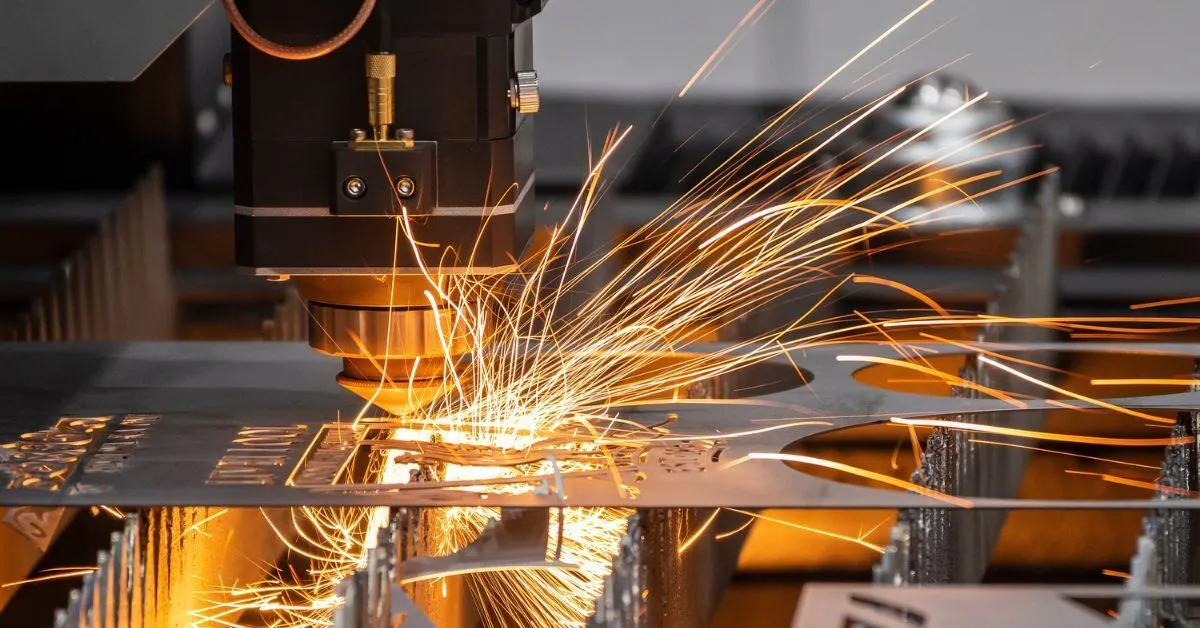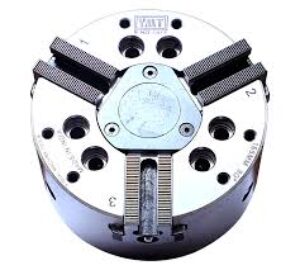

This is image is 3-jaws chuck
A 3-jaw chuck is a type of clamping device used in lathe machines and other machinery to hold cylindrical workpieces securely in place. It’s widely favored for its ease of use and ability to center workpieces quickly. Here’s a detailed look at how it works:
Introduction to 3-Jaw Chucks
A 3-jaw chuck consists of three jaws that move simultaneously to clamp the workpiece. These jaws are usually made of hardened steel and are designed to hold the workpiece securely without causing damage.
Components of a 3-Jaw Chuck
- Jaws: The three jaws are equidistantly spaced around the chuck’s circumference. They move in unison, ensuring the workpiece is centered.
- Scroll Plate: A spiral scroll plate inside the chuck controls the movement of the jaws. As the scroll plate rotates, it pushes the jaws inward or outward.
- Pinion Gear: This gear, turned by a chuck key, rotates the scroll plate.
- Chuck Body: The main structure that houses the jaws, scroll plate, and pinion gear.
How 3-jaws Chuck Works
- Inserting the Workpiece: Place the cylindrical workpiece between the jaws of the chuck.
- Turning the Chuck Key: Insert the chuck key into one of the keyholes on the chuck body and turn it. This action rotates the pinion gear.
- Movement of the Scroll Plate: As the pinion gear turns, it rotates the scroll plate inside the chuck.
- Simultaneous Movement of Jaws: The rotation of the scroll plate causes the jaws to move simultaneously. If you turn the key clockwise, the jaws move inward, clamping the workpiece. Turning it counterclockwise causes the jaws to move outward, releasing the workpiece.
- Self-Centering Action: The simultaneous movement of the jaws ensures that the workpiece is automatically centered. This self-centering feature is a significant advantage of 3-jaw chucks, especially for repetitive tasks.
Advantages of a 3-Jaw Chuck
- Quick and Easy Operation: The self-centering mechanism makes it easy to load and unload workpieces quickly.
- Consistent Centering: Ideal for cylindrical workpieces where precise centering is crucial.
- Versatility: Suitable for a wide range of diameters due to the adjustable jaws.
Limitations of a 3-Jaw Chuck
- Limited to Cylindrical Shapes: Best suited for round or hexagonal workpieces; not ideal for irregular shapes.
- Potential for Inaccuracy: Over time, wear and tear can affect the precision of centering, requiring maintenance or replacement.
- Less Clamping Force: Compared to 4-jaw chucks, the clamping force is less, making it less suitable for heavy-duty applications.
Maintenance Tips
- Regular Cleaning: Keep the chuck clean to prevent debris from affecting the movement of the jaws.
- Lubrication: Regularly lubricate the moving parts to ensure smooth operation.
- Inspection: Periodically inspect the jaws and scroll plate for wear and replace them if necessary.
Conclusion
A 3-jaw chuck is an essential tool in machining for holding cylindrical workpieces securely and ensuring they are centered accurately. Its simplicity and efficiency make it a popular choice for many machining operations, despite some limitations. Proper maintenance and understanding of its working mechanism can extend its life and enhance its performance.
FAQs about 3-Jaw Chucks
1. What is a 3-jaw chuck used for?
A 3-jaw chuck is primarily used to hold cylindrical workpieces securely in place on a lathe or other machinery. It is ideal for tasks requiring precise centering and consistent alignment, such as turning, facing, and boring operations.
2. How does a 3-jaw chuck ensure the workpiece is centered?
A 3-jaw chuck uses a self-centering mechanism, where all three jaws move simultaneously when the chuck key is turned. This ensures the workpiece is automatically centered as the jaws close around it, providing consistent alignment.
3. Can a 3-jaw chuck hold irregularly shaped workpieces?
A 3-jaw chuck is best suited for round or hexagonal workpieces. It is not ideal for irregularly shaped objects because its jaws move simultaneously, which may not secure non-cylindrical shapes properly.
4. What are the advantages of using a 3-jaw chuck?
The main advantages include quick and easy operation due to its self-centering feature, consistent centering of cylindrical workpieces, and versatility for various diameters. It is particularly useful for repetitive tasks that require fast loading and unloading of workpieces.
5. How can I maintain my 3-jaw chuck for optimal performance?
To maintain a 3-jaw chuck:
- Regular Cleaning: Keep the chuck clean to prevent debris buildup.
- Lubrication: Lubricate moving parts regularly to ensure smooth operation.
- Inspection: Periodically check the jaws and scroll plate for wear and tear, replacing them if necessary. Regular maintenance ensures accuracy and extends the life of the chuck.







